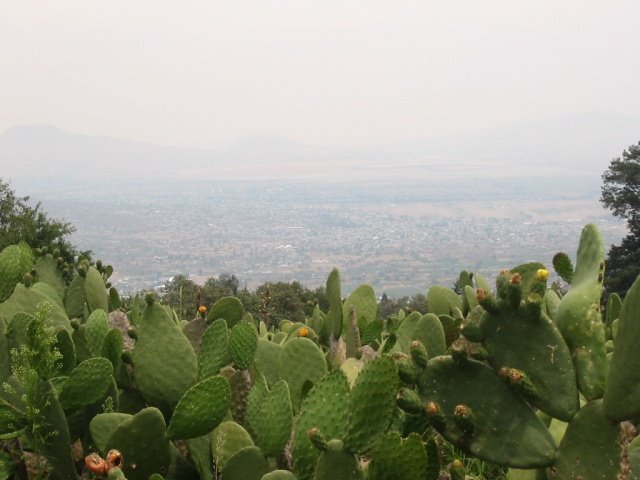
Aarre (aka Hubbie) loves Mexico for its diversity of cacti more than any country in the world...
There are two large deserts in Mexico, the Chihuahuan and the Sonoran, and therein grow most of the cacti lifeforms found in the world.
Researching and writing this article rehabilitated a childhood enthusiasm I had for cacti. And I now have a perspective of cacti within their biome and not just as miniature windowsill beauties.
This post will be rich with photos and links, and I sent out emails to find professional desert eco-tour guides for you. Email me if you already know of one.
I've always been in a state of no-interest at best in the seemingly lifeless desert terrain. I've heard it said that if an ascended being were to remove himself to the desert there would be those who would find him and show up on his doorstep. Yes, there is even life in rocks, and that might be what one can discover for themselves in the desert.
Then there was Jesus (and others) who sojourned 40 days and 40 nights in the desert. Why a desert? Perhaps even demons prefer casinos and cabana lined beaches. An extended desert stay would certainly resolve one's devotion to materialism, there being no shopping malls in the deserts. It would also take one out from under the huge cloud of Group Think that overhangs our cities and media. The worst a trip to the desert can do is make us appreciate even more our return back home to our beautiful lawns and gardens and sandless sheets.
Man as Terraformer
Let me acknowledge though that there are people who, given the choice, would happily live in the desert. My husband, Aarre, is one of those people. There would be Aarre mothering his herd of opuntias and me on the other side making heroic efforts to speed up the evolutionary process of soil building and water retention so that I can enjoy my quarter acre of lawn grass.
Whenever I see a desert my urge has been to create out of it a lush golf-course type of landscape. After studying to write this article I am more inclined to design an Eco-Golf course. Say, this might be catchy! An “Eco-Golf” country club. Eco-golf for the Warrior Golfer.
Life seeks out life and that is partly why I am taking on this study – the urge towards life. To my surprise I did find life in the desert although the paucity of life compared to the lush terrain I grew up in required me to take on an almost microscopic water seeking mentality just as the cacti do. I appreciate the ecological harmony of the highly specialized desert plants and animals. The cacti are the most unusual of this specialized function.
The Chihuahuan Desert:
The largest desert in North America (map) and 80% lies within the Mexican border. Here you find the smaller cacti, in the range of 850 species. It is close to 800 miles long and 250 miles wide, and from 1,000 ft. to 10,000 ft. altitudes.
The greatest variety of cacti is found in the Sierra Madre mountain ranges bordering on the east and on the west. However, it is easier to check out the indigeneous cacti in the valleys of San Luis Potosi State and Puebla State. In Mexico City be sure to visit Chapultepec [grasshopper] Park. Planeta.com has pages and links on ecotourism in Mexico.
The Major Cacti Types:
The Chihuahuan Desert experiences relatively high rainfall in the summer, lime bed soils and cool winter temperatures. There are many small cacti, such as the mammillaria, and few of the larger cacti associated with the Sonoran Desert. The common cacti include the Prickly Pears, Hedgehogs (Echinocereus), Living Rocks (Ariocarpus fissuratus), and Nipple Cacti (mammillaria). They are most likely found on the limestone ridges and ledges (photo shown above).
There are two large deserts in Mexico, the Chihuahuan and the Sonoran, and therein grow most of the cacti lifeforms found in the world.
Researching and writing this article rehabilitated a childhood enthusiasm I had for cacti. And I now have a perspective of cacti within their biome and not just as miniature windowsill beauties.
This post will be rich with photos and links, and I sent out emails to find professional desert eco-tour guides for you. Email me if you already know of one.
I've always been in a state of no-interest at best in the seemingly lifeless desert terrain. I've heard it said that if an ascended being were to remove himself to the desert there would be those who would find him and show up on his doorstep. Yes, there is even life in rocks, and that might be what one can discover for themselves in the desert.
Then there was Jesus (and others) who sojourned 40 days and 40 nights in the desert. Why a desert? Perhaps even demons prefer casinos and cabana lined beaches. An extended desert stay would certainly resolve one's devotion to materialism, there being no shopping malls in the deserts. It would also take one out from under the huge cloud of Group Think that overhangs our cities and media. The worst a trip to the desert can do is make us appreciate even more our return back home to our beautiful lawns and gardens and sandless sheets.
Man as Terraformer
Let me acknowledge though that there are people who, given the choice, would happily live in the desert. My husband, Aarre, is one of those people. There would be Aarre mothering his herd of opuntias and me on the other side making heroic efforts to speed up the evolutionary process of soil building and water retention so that I can enjoy my quarter acre of lawn grass.
Whenever I see a desert my urge has been to create out of it a lush golf-course type of landscape. After studying to write this article I am more inclined to design an Eco-Golf course. Say, this might be catchy! An “Eco-Golf” country club. Eco-golf for the Warrior Golfer.
Life seeks out life and that is partly why I am taking on this study – the urge towards life. To my surprise I did find life in the desert although the paucity of life compared to the lush terrain I grew up in required me to take on an almost microscopic water seeking mentality just as the cacti do. I appreciate the ecological harmony of the highly specialized desert plants and animals. The cacti are the most unusual of this specialized function.
The Chihuahuan Desert:
The largest desert in North America (map) and 80% lies within the Mexican border. Here you find the smaller cacti, in the range of 850 species. It is close to 800 miles long and 250 miles wide, and from 1,000 ft. to 10,000 ft. altitudes.
The greatest variety of cacti is found in the Sierra Madre mountain ranges bordering on the east and on the west. However, it is easier to check out the indigeneous cacti in the valleys of San Luis Potosi State and Puebla State. In Mexico City be sure to visit Chapultepec [grasshopper] Park. Planeta.com has pages and links on ecotourism in Mexico.
The Major Cacti Types:
The Chihuahuan Desert experiences relatively high rainfall in the summer, lime bed soils and cool winter temperatures. There are many small cacti, such as the mammillaria, and few of the larger cacti associated with the Sonoran Desert. The common cacti include the Prickly Pears, Hedgehogs (Echinocereus), Living Rocks (Ariocarpus fissuratus), and Nipple Cacti (mammillaria). They are most likely found on the limestone ridges and ledges (photo shown above).
(To be continued)

